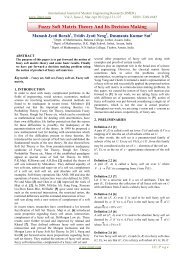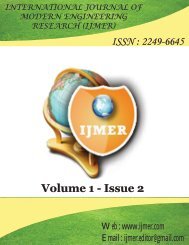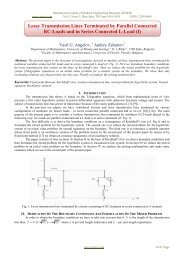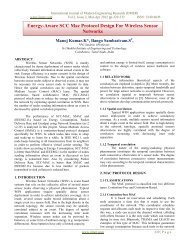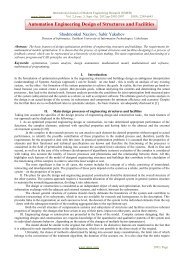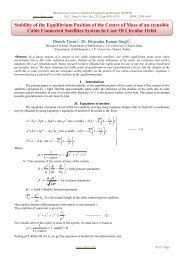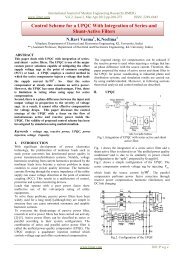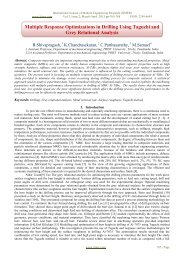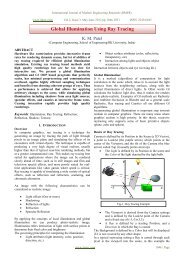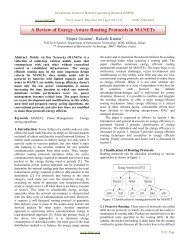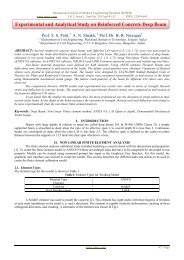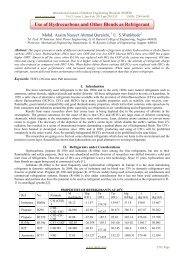IEEE Paper Template in A4 (V1) - ijmer
IEEE Paper Template in A4 (V1) - ijmer
IEEE Paper Template in A4 (V1) - ijmer
You also want an ePaper? Increase the reach of your titles
YUMPU automatically turns print PDFs into web optimized ePapers that Google loves.
International Journal of Modern Eng<strong>in</strong>eer<strong>in</strong>g Research (IJMER)<br />
www.<strong>ijmer</strong>.com Vol.2, Issue.3, May-June 2012 pp-876-881 ISSN: 2249-6645<br />
time-shar<strong>in</strong>g systems. It’s designed to give a better responsive<br />
but the worst turnaround and wait<strong>in</strong>g time due to the fixed<br />
time quantum concept. The scheduler assigns a fixed time unit<br />
(quantum) per process usually 10-100 milliseconds, and<br />
cycles through them. RR is similar to FCFS except that<br />
preemption is added to switch between processes [2, 3, and 8].<br />
1.2RELATED WORK<br />
Matarneh [2] founded that an optimal time quantum<br />
could be calculated by the median of burst times for the set of<br />
processes <strong>in</strong> ready queue, unless if this median is less than<br />
25ms. In such case, the quantum value must be modified to<br />
25ms to avoid the overhead of context switch time [2]. Other<br />
works [7], have also used the median approach, and have<br />
obta<strong>in</strong>ed good results.<br />
Helmy et al. [3] propose a new weight<strong>in</strong>g technique<br />
for Round-Rob<strong>in</strong> CPU schedul<strong>in</strong>g algorithm, as an attempt to<br />
comb<strong>in</strong>e the low schedul<strong>in</strong>g overhead of round rob<strong>in</strong><br />
algorithms and favor short jobs. Higher process weights<br />
means relatively higher time quantum; shorter jobs will be<br />
given more time, so that they will be removed earlier from the<br />
ready queue [3]. Other works have used mathematical<br />
approaches, giv<strong>in</strong>g new procedures us<strong>in</strong>g mathematical<br />
theorems [4].<br />
Mohanty and others also developed other algorithms <strong>in</strong><br />
order to improve the schedul<strong>in</strong>g algorithms performance [5],<br />
[6] and [7]. One of them is constructed as a comb<strong>in</strong>ation of<br />
priority algorithm and RR [5] while the other algorithm is<br />
much similar to a comb<strong>in</strong>ation between SJF and RR [6].<br />
1.2 OUR CONTRIBUTION<br />
In our work, we have scheduled the processes giv<strong>in</strong>g<br />
importance to both the user priority and shortest burst<br />
time priority rather than us<strong>in</strong>g s<strong>in</strong>gle parameter. A new<br />
calculated factor based on both the user priority and the burst<br />
time priority, decides the <strong>in</strong>dividual time quantum for each<br />
process . We have compared the performance of our<br />
proposed Fair Priority Round Rob<strong>in</strong> with Dynamic Time<br />
Quantum(FPRRDQ) algorithm with the Priority Based<br />
Static Round Rob<strong>in</strong>(PBSRR) algorithm and Shortest<br />
Execution First Dynamic Round Rob<strong>in</strong>(SEFDRR).<br />
Experimental results show that our proposed algorithm<br />
performs better than PBSRR and SEFDR .<br />
2.1. UNIQUENESS OF OUR APPROACH<br />
Generally with every process two factors are<br />
associated. These factors are user priority and burst time.<br />
Above factors play an important role to decide <strong>in</strong> which<br />
sequence the processes will be executed. Sort<strong>in</strong>g accord<strong>in</strong>g to<br />
the importance of these factors, user priority comes first, and<br />
then the burst time. In FCFS, SJF and Priority algorithms,<br />
only one among these two factors are taken <strong>in</strong>to<br />
consideration. If we mix up all these factors to<br />
calculate the <strong>in</strong>dividual time quantum of each process then<br />
average wait<strong>in</strong>g time, average turnaround time and number<br />
of context switches will be decreased. But FCFS, SJF and<br />
Priority schedul<strong>in</strong>g algorithms are non-preemptive <strong>in</strong> nature<br />
and they can’t be used <strong>in</strong> time shar<strong>in</strong>g systems. So to<br />
<strong>in</strong>crease the responsiveness of the system, RR algorithm<br />
should be used. Generally <strong>in</strong> RR algorithm, processes are<br />
taken from the ready queue <strong>in</strong> FCFS manner for execution.<br />
But <strong>in</strong> our algorithm, is calculated for each process.<br />
S<strong>in</strong>ce , <strong>in</strong> the previously existed algorithsm like<br />
PBSRR and EFDR ,they don’t pay more attention regard<strong>in</strong>g<br />
the user priority and burst priority (weight of the process<br />
given accord<strong>in</strong>g to the burst time i.e. shorter burst process<br />
hav<strong>in</strong>g more weight) of the process that the process with<br />
higher user priority and Weight (burst) should get more time<br />
quantum value for the execution of that process. That’s why ,<br />
we can say that the time quatum given to a process is<br />
<strong>in</strong>versely proportional to the user priority(Pr i ) and directly<br />
proportional to the weight of the process (i.e. given accord<strong>in</strong>g<br />
to the burst time of the process W i ).<br />
So for the time quantum calculation for processs i is give as:-<br />
TQ=(∑ N i=1Bt i /N)*W i /pr i ..........................................(1)<br />
2.2. PSEUDO CODE FOR FPRRDQ ALGORITHM<br />
Here,<br />
N = No. of processes<br />
W i = Weight of Pi based on burst time of the<br />
process.(Shorter burst processes are assigned more weight).<br />
Input:<br />
No of processes(P1, P2, ……., Pn),<br />
1.4.ORGANIZATION OF THE PAPER<br />
In Section II, the pseudo code and illustration<br />
of our proposed FPRRDQ algorithm is presented. Section<br />
III shows the results of experimental analysis of FPRRDQ<br />
and its comparison with PBSRR and SEFDR. Conclusion and<br />
directions for future work is given <strong>in</strong> Section IV.<br />
2. OUR PROPOSED ALGORITHM<br />
Output:<br />
Burst time of processes (Bt1, Bt2,….,Btn),<br />
Priority of processes (Pr1, Pr2,……,Prn).<br />
Tav = Average turnaround time,<br />
Wav = Average wait<strong>in</strong>g time,<br />
Ncs = Number of context switches.<br />
www.<strong>ijmer</strong>.com<br />
877 | Page




